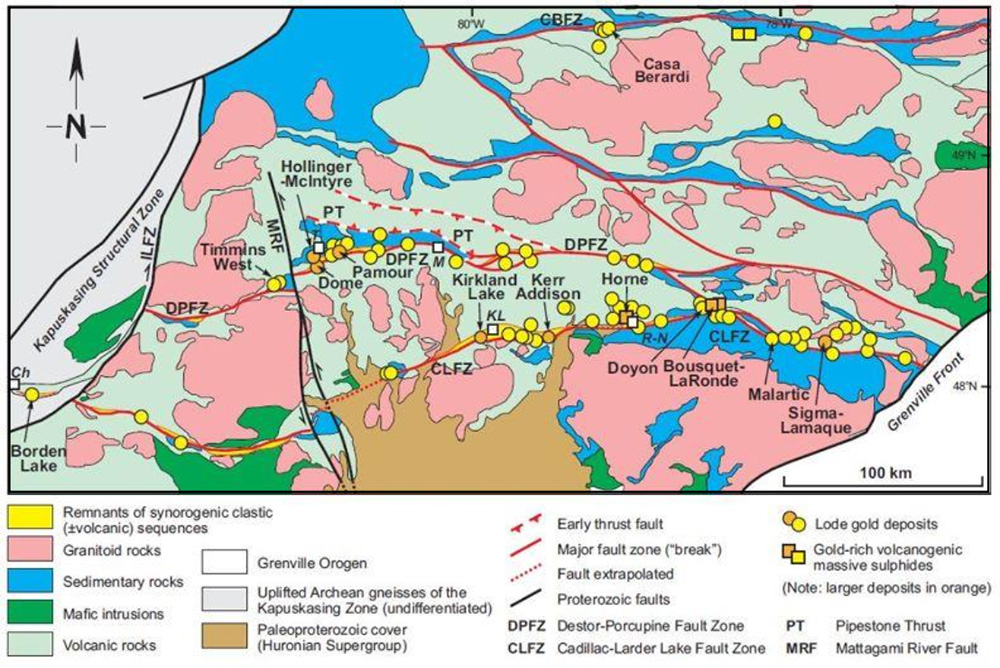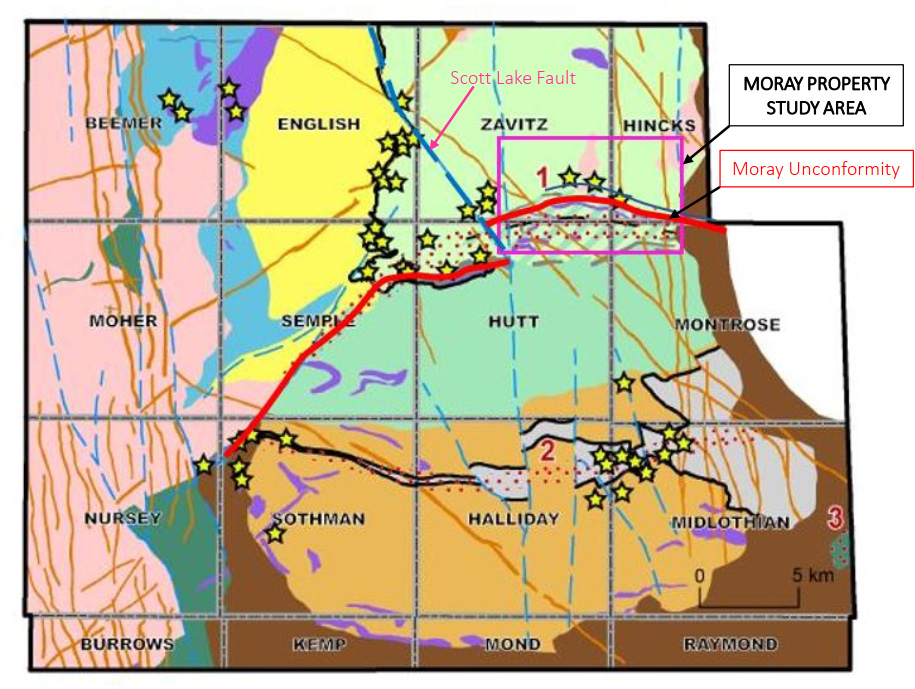I agree to and consent to receive news, updates, and other communications by way of commercial electronic messages (including email) from New Break Resources Ltd. I understand I may withdraw consent at any time by clicking the unsubscribe link contained in all emails from New Break Resources Ltd.
Moray Gold Project – Geology and Mineralization
The Moray Property lies within a portion of the Abitibi greenstone belt, which has long been central to understanding greenstone belt mineral deposits. The Cadillac Larder-Lake Fault Zone (“CLFZ”) is one of two major “breaks” in the Southern Abitibi greenstone belt, the other being the Destor-Porcupine Fault Zone (“DPFZ”). Gold mineralization at Moray is thought to exist in a major splay off of the CLFZ. Several producing and past-producing gold, volcanogenic massive sulfide (“VMS”) and nickel mines are located within a 100 km radius of the Moray Property.
Geologic Map of the Southern and Central Abitibi Greenstone
The Moray Property is underlain by Archean volcanic tectono-stratigraphy flanking the eastern and northern flanks of the Bartlett Dome and Halliday Dome, respectfully. Major lithologies include basaltic flows and pillow lavas with intermediate andesite to rhyolite and various forms of breccias and tuffs. Diabase dykes and north to northwest trending faults cut the lithologic units.
Bartlett and Halliday Domes Showing Extensions of CLFZ
There are 13 showings recognized in the Ontario Mineral Deposit Inventory on the property.
- three gold showings including the Voyager gold and copper Showing and the Fiset gold and silver (“Ag”) Showing hosted in syenite;
- four base metal showings: Copper (“Cu”), Lead (“Pb”, Zinc (“Zn”), Nickel (“Ni”); and
- six nickel showings.
The Fiset gold and silver Showing, discovered by H.G. Robinson in 1938, consists of stringers in sheared, highly altered, mafic metavolcanics and silicified syenite and up to 1% gold-bearing quartz veinlets measuring 5 to 50 cm in width. Most of the gold mineralization is associated with syenite intrusive rock, similar to the geological and structural setting hosting the Young-Davidson deposit. Historic exploration reports that Noranda removed a selected 75 lb. sample from the gold occurrence near the western end of the syenite stock which returned an assay of 23.44 g/t Au, 121.88 g/t Ag and 0.45% Pb. Work carried out in 1999 by Claim Lake Resources Inc., depicts the syenite stock extending to the West. A similarity can be noted between the Fiset gold showing hosted within a syenite stock and the Young-Davidson Mine where disseminated gold and silver mineralization located within, and close to, a syenite porphyry intrusion is mined underground and by open pit for disseminated gold.
The Voyager gold and copper Showing is exposed in three trenches and consists of disseminated to massive pyrrhotite, pyrite and minor chalcopyrite in a north-northwest trending sequence of pillow lavas, andesites and rhyolite tuffs. December 1964, drilling by Voyager and Silvermaque intersected 13.7 metres of 1-2% disseminated pyrite and pyrrhotite in felsic breccia in hole 64-2, with 1.2 metres of massive pyrite-pyrrhotite grading 11.3 g/t Au and 0.46% Cu at a depth of 18.7 metres. Hole 64-4, located approximately 30 metres southeast from hole 64-2, intersected 1.5 metres of massive pyrite-pyrrhotite grading 1.03 g/t Au and 0.91% Cu. Drilling by Newmont in 1980 intersected mafic volcanics and 1.2 metres of semi-massive pyrite with 5% pyrrhotite-chalcopyrite and 76 metres of 15% pyrite-pyrrhotite. Further drilling intersected up to 5% disseminated sulfides with narrow sections of 20% sulfides.


